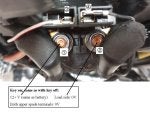Firstly, based on many posts I have read regarding the Bonneville, the problem I am having is a perennial one that Triumph has never solved. I'm hoping to get the attention of Carl S and/or MacBandit:
I’m now doubting that the issue has anything to do with the battery per se.
So my question is:
Is it usual that a 2016 Bonneville with only 3300 miles on it would have a starter solenoid go south ??? My diagnostics are pointing to a failed solenoid.
- After about 7 years, I am having starting issues with my 2016 Bonneville T100 (only 3300 miles!). Even with a “good” battery (am now on my second new battery), the starting success is intermittent – mostly a fail: all I get are clicks at the starter solenoid.
- Right out of the box, the 2nd new battery I’ve obtained (180 cca) tested at 12.97V. When installed, it started my motorcycle right away. After running for a minute, I shut it down and after a few seconds, started again. I may have done the once more and then it began failing again: I only got clicks at the starter solenoid. I tried to start the motorcycle again several times thereafter and same result: click at the solenoid !! The battery voltage held to at least 12.6V, which was good. For the hell of it, I had it tested at AutoZone and – unsurprisingly - it came back totally healthy. Then I attached jumper cables from my pickup and the motorcycle started right up !! When the cables were disconnected, it again failed: clicks at the solenoid
I’m now doubting that the issue has anything to do with the battery per se.
So my question is:
Is it usual that a 2016 Bonneville with only 3300 miles on it would have a starter solenoid go south ??? My diagnostics are pointing to a failed solenoid.















